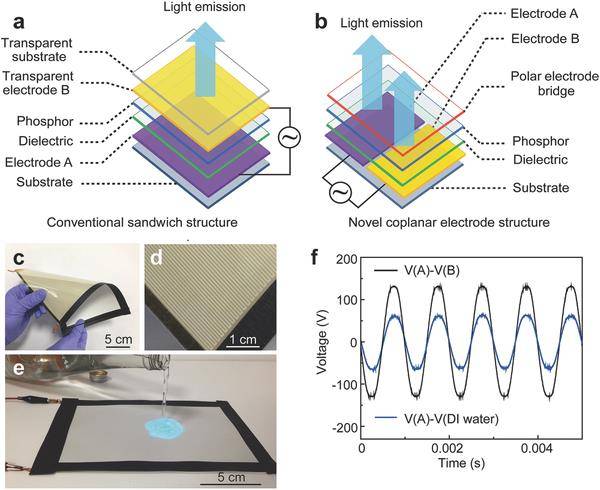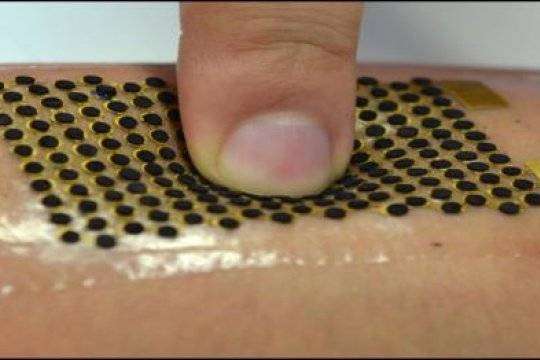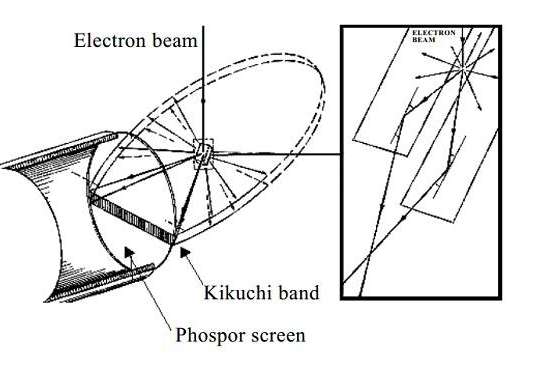【introduction】The construction of flexible electronic devices with certain functions and structures provides a variety of possibilities for human life in the future, such as wearable electronic products, implantable chips, sensing skin, flexible robots, and so on. With the deepening of the research on luminescent materials, these creative products are moving from the laboratory to people’s lives. For example, a clothing containing a light-emitting element, a detector built by an optical signal, a chip capable of releasing a drug through an optical signal, a chip that participates in a signal transmission, and the like. Early research, mainly using screen printing technology, to achieve a large-scale manufacturing of AC flexible luminescent materials. Nowadays, with the advent of 3D printing technology, flexible materials with more complex structures are also produced.The researchers have designed a novel structure of light-emitting devices, which are mainly composed of four parts, namely, a pair of parallel stack or side by side distribution of the electrode, light-emitting layer, dielectric layer and a controllable electrode layer. The control of the electrode layer is achieved by selecting a different polarizing material or an electroconductive thin film. This new structure is not only simple, but also conducive to large-scale manufacturing, more importantly, compared with the traditional sense of the light-emitting devices, a pair of opposing electrodes are no longer stacked with each other, but side by side distribution. It is because of this structural advantage, the researchers have designed different types of devices. For example, this flexible material is mounted on an umbrella, and when the water falls on an umbrella, the umbrella glows, which also makes it possible to build a remote detector that utilizes optical signal changes.Figure 1. Comparison of conventional sandwich configurations of light emitting devices (denoted as S-ELS) and polarized electrode bridge light emitting devices (denoted PEB-ELS)a) Schematic diagram of the structure of a conventional sandwich device (S-ELS)b) Schematic diagram of polarization electrode bridge light emitting device (PEB-ELS)c) Flexible display of PEB-ELS;d) The backside of the PEB-ELS is enlarged with an electrode width of 0.45 mm and a pitch of 0.40 mm.e) the water shines on the PEB-ELS;f) Comparison of changes in AC voltage before and after water dumping.Figure 2. Effect of bridging material, voltage and frequency on PEB-ELS performancea) PEB-ELS positive partial magnification, electrode width of 1.5 mm, spacing of 0.4 mm;b) the addition of different bridging liquid, the light in the dark situation;c) the relationship between the luminous intensity and the type and concentration of the bridged liquid at a voltage frequency of 2 kHz;d) the effect of substrate impedance on the luminous intensity, insert the picture shows the relationship between liquid contact time and luminous intensity;e) the relationship between the luminous intensity and the voltage frequency when the voltage is constant;f) Draw a Picasso painting on PEB-ELS with a pencil.Figure 3. Polarized electrode bridge experiment.a-b) bridging the experimental diagram, the first PEB-ELS is divided into two parts, and then use the hydrogel as a polarized bridge, the two parts connected to test;c) half of the PEB-ELS infiltrated in the two beakers;d) Transparent polyacrylamide hydrogel for bridging, 5 cm long, 1.6 cm wide, 0.3 cm thick;e) After the two beakers are connected with a hydrogel, the voltage is applied and the PEB-ELS emits light;f) Place the hydrogel directly on PEB-ELS and the material glows.Figure 4. Preparation and performance testing of rainwater sensorsa-b) rainwater sensor preparation diagram;c-d) rainwater sensor of the physical map, white and dark;e) hand as bridge electrode, PEB-ELS light;f) When the water is frozen, the emission intensity of PEB-ELS is weakened.【summary】This study presents a new, low-cost, flexible, light-emitting device that can be mass-produced. In this paper, the luminescence performance of the device is studied, and the relationship between the luminescence performance and the bridging material and the applied voltage is discussed. And then made it based on the optical signal sensor. When the umbrella is wet or touched by hand, the contact surface will light. Not only that, this new type of light emitting device can also be used to write, when writing with a pencil, the corresponding area can also light. This also provides a new possibility for the future development of touch display technology.
Source: Meeyou Carbide



